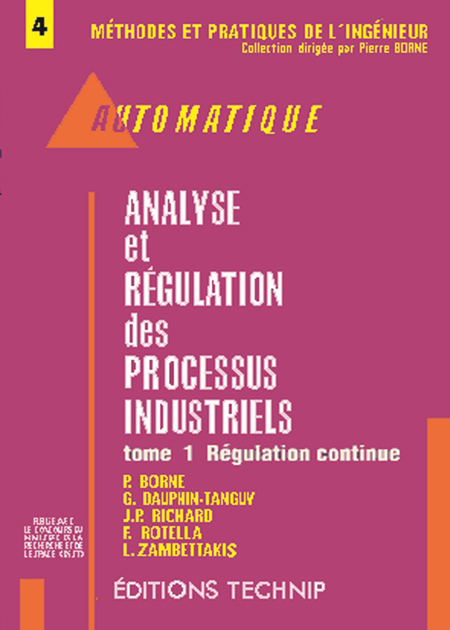Analyse et régulation des processus industriels. Tome 1. Régulation continue
Authors : BORNE Pierre , DAUPHIN-TANGUY Geneviève , RICHARD Jean-Pierre , ROTELLA Frédéric , ZAMBETTAKIS Irène
ISBN : 9782710806424
trade paperback 16 x 24 cm 504 pages
Publication date : 1993
 Add to cart 80 $ (74 €)
Add to cart 80 $ (74 €)
Le tome 1 reprend sans les développer les notions de base relatives au calcul opérationnel (transformée de Laplace et ses applications) et redéfinit l’ensemble des notions indispensables relatives aux signaux et systèmes dans l’optique de présenter les différentes méthodes d’analyse et régulation des processus continus. De nombreux exemples illustrent tout au long du texte la mise en œuvre des méthodes présentées. De plus, un chapitre entier est consacré à la résolution de problèmes pratiques de régulation.
Contents :
1. Processus et asservissement. 2. Éléments intervenant dans les processus asservis. 3. Signaux continus. 4. Fonction de transfert d’un filtre linéaire. 5. Graphes de fluence. 6. Représentation fréquentielle des fonctions de transfert. 7. Représentation d’un système continu dans l’espace d’état. 8. Comportement temporel des systèmes continus. 9. Signaux aléatoires continus. 10. Stabilité des systèmes continus linéaires. 11. Précision des systèmes asservis. 12. Observabilité et commandabilité. 13. Régulation continue. 14. Synthèse de régulations continues par l’abaque de Black-Nichols. 15. Méthodes simplifiées de synthèse de régulations continues. 16. Synthèse d’un asservissement continu par la méthode du lieu d’Evans. 17. Synthèse de régulations dans l’espace d’état. 18. Commande à minimum de variance, détermination d’un filtre optimal. 19. Réalisation pratique de réseaux correcteurs continus. 20. Systèmes non linéaires, linéarisation. 21. Approximation du premier harmonique. 22. Effet d’une non-linéarité placée dans la boucle de régulation. 23. Stabilité des systèmes continus non linéaires. 24. Méthodes d’identification. 25. Problèmes résolus. Bibliographie. Index.

 Partager
Partager
 Tweeter
Tweeter
